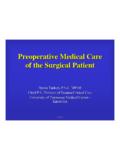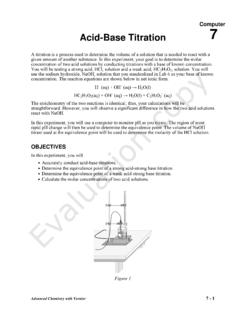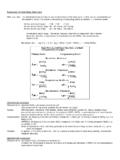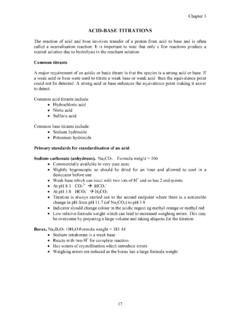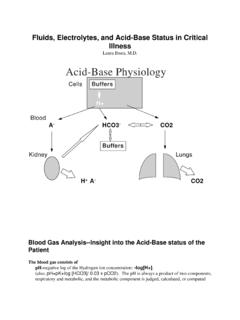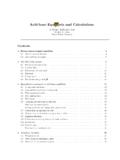Transcription of Acid/Base and ABG Interpretation Made Simple
1 Acid/Base and ABG Acid/Base and ABG Interpretation Made Interpretation Made SimpleSimpleAA--a Gradienta Gradient FIO2 = PA O2 + (5/4) PaCO2 FIO2 = PA O2 + (5/4) PaCO2 FIO2 = 713 x O2%FIO2 = 713 x O2% AA--a gradient = PA O2 a gradient = PA O2 --PaO2 PaO2 Normal is 0 Normal is 0--10 mm Hg10 mm Hg + x age in + x age in years With higher inspired O2 concentrations, With higher inspired O2 concentrations, the Athe A--a gradient will also increasea gradient will also increasePaO2 PaO2--FiO2 ratioFiO2 ratio Normal PaO2/FiO2 is 300 Normal PaO2/FiO2 is 300--500500 <250 indicates a clinically significant gas <250 indicates a clinically significant gas exchange derangementexchange derangement Ratio often used clinically in ICU settingRatio often used clinically in ICU settingHypoxemiaHypoxemia HypoventilationHypoventilation V/Q mismatchV/Q mismatch RightRight--Left shuntingLeft shunting Diffusion impairmentDiffusion impairment Reduced inspired oxygen tensionReduced inspired oxygen tensionHypoventilationHypoventilation CNS depression (OD or CNS depression (OD or structural/ischemic CNS lesions involving structural/ischemic CNS lesions involving respiratory center)respiratory center) Neural conduction D/ONeural conduction D/O s (amyotrophic s (amyotrophic lateral sclerosis, lateral sclerosis, GuillainGuillain--BarreBarre, high , high cervical spine injury))
2 Cervical spine injury) Muscular weakness (Muscular weakness (polymositispolymositis, MD), MD) Diseases of chest wall (flail chest, Diseases of chest wall (flail chest, kyphoscoliosiskyphoscoliosis))V/Q mismatchV/Q mismatch Lung regions with low ventilation Lung regions with low ventilation compared to perfusion will have low compared to perfusion will have low alveolar oxygen content and high CO2 alveolar oxygen content and high CO2 contentcontent Lung regions with high ventilation Lung regions with high ventilation compared to perfusion will have a low compared to perfusion will have a low CO2 content and high oxygen contentCO2 content and high oxygen content V/Q varies with position in lung (lower in V/Q varies with position in lung (lower in basilar than apical) basilar than apical) WEST ZONESWEST ZONESD iseases that affect V/QDiseases that affect V/Q Obstructive lung diseasesObstructive lung diseases Pulmonary vascular diseasesPulmonary vascular diseases ParenchymalParenchymallung diseaseslung diseasesRight to Left ShuntRight to Left Shunt Extreme example of V/Q mismatchExtreme example of V/Q mismatch Shunt physiology may result from Shunt physiology may result from parenchymalparenchymaldiseases leading to diseases leading to atelectasisatelectasisor alveolar flooding (lobar or alveolar flooding (lobar pneumonia or ARDS)pneumonia or ARDS) Can also occur from pathologic vascular Can also occur from pathologic vascular communications (AVM or communications (AVM or intracardiacintracardiacshunts)shunts)
3 Diffusion ImpairmentDiffusion Impairment When available path for movement of When available path for movement of oxygen from alveolus to capillary is alteredoxygen from alveolus to capillary is altered Diffuse Diffuse fibroticfibroticdiseases are the classic diseases are the classic entitiesentitiesReduced inspired oxygen Reduced inspired oxygen deliverydelivery Delivery to tissue beds determined by Delivery to tissue beds determined by arterial oxygen content and cardiac outputarterial oxygen content and cardiac output Oxygen content of blood is affected by Oxygen content of blood is affected by level and affinity state of hemoglobinlevel and affinity state of hemoglobin Example is CO poisoning: reduction of arterial O2 content Example is CO poisoning: reduction of arterial O2 content despite normal PaO2 and despite normal PaO2 and HgbHgbcaused by reduction in available caused by reduction in available O2 binding sites on the O2 binding sites on the HgbHgbmoleculemolecule Reduced CO will lead to impairment in Reduced CO will lead to impairment in tissue O2 delivery and hypoxemia and tissue O2 delivery and hypoxemia and lactic acidosislactic acidosisOxygen Delivery, Delivery, cont.
4 Tissue hypoxia may occur despite Tissue hypoxia may occur despite adequate oxygen deliveryadequate oxygen delivery CN poisoning causes interference with oxygen utilization by the CN poisoning causes interference with oxygen utilization by the cellular cellular cytochromecytochromesystem, leading to cellular hypoxiasystem, leading to cellular hypoxia Disease states such as sepsis may result Disease states such as sepsis may result in tissue ischemia possibly because of in tissue ischemia possibly because of diversion of blood flow away from vital diversion of blood flow away from vital organsorgansACID/BASEACID/ base 15,000 15,000 mmolmmolof CO2 (generates H2CO2) of CO2 (generates H2CO2) and 50and 50--100 100 meqmeqof nonvolatile acid of nonvolatile acid (mostly sulfuric from sulfur(mostly sulfuric from sulfur--containing containing amino acids) are madeamino acids) are made Balance is maintained by normal Balance is maintained by normal pulmonary and renal excretion of these pulmonary and renal excretion of these acidsacidsRenal excretionRenal excretion Involves the combination of hydrogen ions Involves the combination of hydrogen ions with urinary with urinary titratabletitratableacid, particularly acid , particularly phosphate (HPO42phosphate (HPO42--+ H+ to H2PO4+ H+ to H2PO4--) or ) or with ammonia to form ammoniumwith ammonia to form ammonium Ammonium is the primary adaptive Ammonium is the primary adaptive response since ammonia production from response since ammonia production from the metabolism of glutamine can be the metabolism of glutamine can be increased in the presence of an acid loadincreased in the presence of an acid loadDefinitionsDefinitions Acidosis: process that lowers the ECF pH by a Acidosis.
5 Process that lowers the ECF pH by a fall in HCO3 or elevation in PCO2fall in HCO3 or elevation in PCO2 Alkalosis: process that raises ECF pH by an Alkalosis: process that raises ECF pH by an elevation in ECF HCO3 or fall in PCO2elevation in ECF HCO3 or fall in PCO2 Met Acidosis: low pH and low Met Acidosis: low pH and low bicarbbicarb Met Alkalosis: high pH and high Met Alkalosis: high pH and high bicarbbicarb RespRespAcidosis: low pH and high PCO2 Acidosis: low pH and high PCO2 RespRespAlkalosis: high pH and low PCO2 Alkalosis: high pH and low PCO2 Metabolic AcidosisMetabolic Acidosis Respiratory compensation results in mm Hg Respiratory compensation results in mm Hg fall in PCO2 for every 1 fall in PCO2 for every 1 meqmeq/L fall in /L fall in bicarbbicarb pCO2 = (HCO3) + 8pCO2 = (HCO3) + 8 DONDON T LEARN IT!!!T LEARN IT!!! OR Last two digits of pH should equal PCO2OR Last two digits of pH should equal PCO2 if equal = no respiratory disturbancesif equal = no respiratory disturbances if PCO2 high = overlapping respiratory acidosisif PCO2 high = overlapping respiratory acidosis if PCO2 low = overlapping respiratory alkalosisif PCO2 low = overlapping respiratory alkalosisMetabolic Acidosis, Acidosis, cont.
6 Calculate anion gap on chem7 Calculate anion gap on chem7 Na Na --((ClCl+ CO2) = around 8+ CO2) = around 8 If > 8 = Anion Gap metabolic acidosisIf > 8 = Anion Gap metabolic acidosisMetabolic AcidosisMetabolic Add delta gap back to CO2 = corrected Add delta gap back to CO2 = corrected bicarbbicarb if corrected if corrected bicarbbicarb= 24= 24--26 then no other 26 then no other disturbancedisturbance if corrected if corrected bicarbbicarb< 24< 24--26 then non26 then non--anion gap anion gap acidosis is superimposed (or chronic acidosis is superimposed (or chronic resprespalkalosis)alkalosis) if corrected if corrected bicarbbicarb>24>24--26 then met alkalosis is 26 then met alkalosis is superimposed (or chronic superimposed (or chronic resprespacidosis)acidosis) if <8 = Non Anion Gap metabolic acidosisif <8 = Non Anion Gap metabolic acidosisMetabolic AlkalosisMetabolic Alkalosis Respiratory compensation raises PCO2 by Respiratory compensation raises PCO2 by mmHg for every 1 mmHg for every 1 meqmeq/L rise in HCO3/L rise in HCO3 Causes include vomiting, intake of alkali, Causes include vomiting, intake of alkali, diuretics, or very commonly, NG suction without diuretics, or very commonly, NG suction without the use of protonthe use of proton--pump inhibitors or H2 blockerspump inhibitors or H2 blockersRespiratory AcidosisRespiratory Acidosis Compensation occurs in 2 stepsCompensation occurs in 2 steps 1.
7 Cell buffering that acts within minutes to hours1. Cell buffering that acts within minutes to hours 2. Renal compensation that is not complete for 32. Renal compensation that is not complete for 3--5 5 daysdays IN ACUTE: IN ACUTE: BicarbBicarbrises 1 rises 1 meqmeq/L for every /L for every 10 mmHg elevation in PCO210 mmHg elevation in PCO2 or for every 1 up of PCO2, pH should fall .0075or for every 1 up of PCO2, pH should fall .0075 IN CHRONIC: IN CHRONIC: BicarbBicarbrises for every 10rises for every 10 or for every 1 up of PCO2, pH should fall .0025or for every 1 up of PCO2, pH should fall .0025 due to tighter control of pH by increased renal excretion of acidue to tighter control of pH by increased renal excretion of acid d as ammoniumas ammoniumRespiratory AlkalosisRespiratory Alkalosis ACUTE: Plasma ACUTE: Plasma bicarbbicarbfalls by 2 for every falls by 2 for every 10 fall in PCO210 fall in PCO2 CHRONIC: CHRONIC: BicarbBicarbfalls by 4 for every 10 falls by 4 for every 10 fall in PCO2fall in PCO2TO SUM UPTO SUM Respiratory AcidosisRespiratory Acidosis HCO3 goes UP by:HCO3 goes UP by: 1 in acute (for 10 PCO2 1 in acute (for 10 PCO2 up)up) in chronic (for 10 in chronic (for 10 PCO2 up) = just PCO2 up) = just remember 3, not for remember 3, not for memory purposes Respiratory AlkalosisRespiratory Alkalosis HCO3 goes DOWN:HCO3 goes DOWN.
8 2 in acute (for 10 PCO2 2 in acute (for 10 PCO2 down)down) 4 in chronic (for 10 4 in chronic (for 10 PCO2 down) PCO2 down) memory For the respiratory compensation For the respiratory compensation calculations, EVERYTHING is in units of calculations, EVERYTHING is in units of 10 mm Hg PCO210 mm Hg PCO2 You just have to remember 4 numbers and You just have to remember 4 numbers and remember that it starts with Acute remember that it starts with Acute 1, 3, 2, and 1, 3, 2, and 4!!!4!!!Anion GapAnion Gap Anion Gap = Na Anion Gap = Na --((ClCl+ HCO3) = UA + HCO3) = UA UCUC Because Na + UC has to equal Because Na + UC has to equal ClCl+ HCO3 + UA+ HCO3 + UA Remember algebra?Remember algebra? UA = Unmeasured anions = albumin, UA = Unmeasured anions = albumin, phosphate, sulfate, lactatephosphate, sulfate, lactate UC = Unmeasured UC = Unmeasured cationscations= Ca, K, Mg= Ca, K, MgLow Anion GapLow Anion Gap Caused by decrease in UACaused by decrease in UA albuminuriaalbuminuriasecondary to secondary to nephroticnephroticsyndromesyndrome Caused by increase in UCCaused by increase in UC Multiple Multiple myelomamyeloma(positively charged (positively charged AbAb ss))Delta GapDelta Gap Delta Gap = AG Delta Gap = AG --88 Corrected Corrected BicarbBicarb= = BicarbBicarb+ delta gap+ delta gap 2424--26 roughly = no other d/o26 roughly = no other d/o <24<24--26 = 26 = hyperchloremichyperchloremicacidosis or acidosis or chronic chronic resprespalkalosisalkalosis >24>24--26 = metabolic alkalosis or chronic 26 = metabolic alkalosis or chronic resprespacidosisacidosisChloride/Sodium CorrectionChloride/Sodium Correction 7/10 rule.
9 Multiply Na excess by and 7/10 rule : Multiply Na excess by and add to chlorideadd to chloride if if hypochloremichypochloremic= metabolic alkalosis or = metabolic alkalosis or chronic chronic resprespacidosisacidosis if if hyperchloremichyperchloremic= metabolic acidosis or = metabolic acidosis or chronic chronic resprespalkalosis alkalosis Approach To ALL Acid/Base Approach To ALL Acid/Base ProblemsProblems DonDon t get overwhelmed by all the numbers t get overwhelmed by all the numbers at once!at once! Use a methodical system to dissect the Use a methodical system to dissect the numbers, and you will never be stumped numbers, and you will never be stumped (almost never).(almost never). DonDon t jump ahead when doing t jump ahead when doing SYSTEMMETHODICAL SYSTEM Get all your numbers in front you firstGet all your numbers in front you ChemChem8 + ABG, or sometimes just ABG8 + ABG, or sometimes just ABG Look at pH first: Look at pH first: AcidoticAcidoticor or alkaloticalkalotic?
10 ? Metabolic or Respiratory?Metabolic or Respiratory? Go straight to Go straight to BicarbBicarb!! Correlate Correlate bicarbbicarbwith PCO2 and it should be with PCO2 and it should be obviousobvious Calculate anion gap no matter what the Calculate anion gap no matter what the disturbance is!disturbance is! After you come up with After you come up with primary disturbanceprimary disturbance , , your next question should ALWAYS BE =your next question should ALWAYS BE = Is there compensation?Is there compensation? For metabolic acidosisFor metabolic last two digits of pH do last two digits of pH equal PCO2 or notequal PCO2 or not For For it acute or chronic, and is is it acute or chronic, and is the HCO3 up appropriately?the HCO3 up appropriately? For For it acute or chronic, and is is it acute or chronic, and is the HCO3 down appropriately?the HCO3 down appropriately?CompensationCompensationTh e Two Given Rules of Compensation:The Two Given Rules of = BICARB (HCO3)METABOLIC = BICARB (HCO3).




